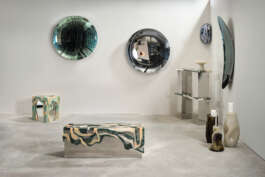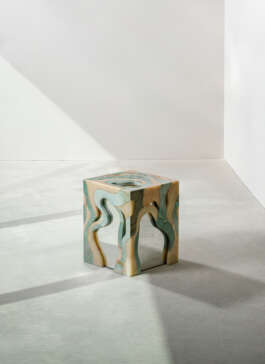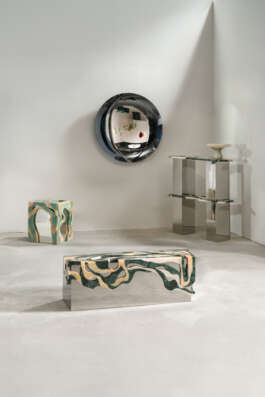



COLLECTIBLE In-Depth
HOMA
September 2025
© Simon Leung & HOMA
This series, COLLECTIBLE In-Depth, unveils the backstage of contemporary creation. Tackling various topics from personal designer processes to the position of collectible design on the global design market, COLLECTIBLE In-Depth offers different views to suit all tastes. Today we speak with Tuğba Koç, designer and creative director of HOMA.
COLLECTIBLE: Why do you focus on contemporary collectible design? What does it mean for you?
Tuğba Koç: Collectible design gives me the freedom to move between fine art and applied design — to create objects that are both functional and emotionally resonant. What excites me most is its process-driven nature: materials like glass, brass, copper, and stone become storytellers, carrying history, transformation, and human touch.
Each piece celebrates craftsmanship while embracing experimentation and imperfection, resisting the uniformity of mass production. For me, collectible design is about presence — creating works that evoke emotion, invite interaction, and form a dialogue with their surroundings.
Materials carry memory, reflection reveals more than an image, and stone, glass, and metal become echoes of time. In my vision, craft is intelligence, transformation is transcendence, and design is not only to be seen but to be felt.
C: How does the cultural diversity of your city influence your design choices and the narratives behind your collectible pieces?
TK: Istanbul is a city of contrasts — where East and West converge, and where forgotten crafts still breathe in hidden corners. Growing up in Vienna gave me a sense of discipline and order, while Istanbul offers chaos, rhythm, and possibility. My work lives in the tension between these two worlds: balancing precision with spontaneity, tradition with experimentation. Each piece carries these echoes of heritage, yet speaks in a timely voice.
C: How do collaborations with artisans or craftspeople influence the final outcome of your collectible design pieces?
TK: Craftsmanship is inseparable from my practice. I first learned mirroring from a master artisan and gradually developed my own experimental language of patinas, textures, and reflective surfaces. Around the same time, I began working with glass — a limitless and magical world I never left.
At HOMA, my women-based team and I work side by side with artisans, from glassblowers to stone carvers, present at every stage from concept to making. These collaborations are not outsourcing but shared authorship — each piece carries the imprint of many hands and many breaths, giving it depth, character, and life.
C: Can you talk about a new piece / collection that you release for COLLECTIBLE this year?
TK: This year at Collectible New York, we’re presenting new works from the ORBIS Collection — pieces that merge art and utility, shaped from reclaimed marble and onyx fragments. The Orbis Collection is about transformation: reclaimed marble is reborn around a mirrored core, its flowing forms recalling ornament yet reshaped through reimagined techniques. Stone appears frozen in a moment of motion, embodying the very idea of change. Supported by reflective surfaces, each piece creates a dialogue between solidity and illusion, weight and fluidity, memory and presence.
Following Collectible Brussels 2025, the series now expands with the Orbis Side Table, Shelf, and Bench, continuing our exploration of material memory and contrast. Each work bridges material with contemporary expression, where reflection takes on a sculptural presence and fragments come together as a whole. In a world fixated on perfection, Orbis celebrates contradiction and intuition, revealing the beauty that emerges through transformation.
C: What makes design collectible in your eyes?
TK: What makes a piece collectible is its presence — its ability to transcend function and carry memory. A collectible work holds the trace of the maker’s hand, the story of the material, and the intention behind its creation. It isn’t defined by rarity but by the layers it carries — material, historical, and emotional. The true collectible reveals itself slowly, drawing you in over time, until it becomes not just an object in space, but part of your own story.

© Simon Leung & HOMA

© Simon Leung & HOMA

©
COLLECTIBLE In-Depth
HOMA
September 2025
This series, COLLECTIBLE In-Depth, unveils the backstage of contemporary creation. Tackling various topics from personal designer processes to the position of collectible design on the global design market, COLLECTIBLE In-Depth offers different views to suit all tastes. Today we speak with Tuğba Koç, designer and creative director of HOMA.
COLLECTIBLE: Why do you focus on contemporary collectible design? What does it mean for you?
Tuğba Koç: Collectible design gives me the freedom to move between fine art and applied design — to create objects that are both functional and emotionally resonant. What excites me most is its process-driven nature: materials like glass, brass, copper, and stone become storytellers, carrying history, transformation, and human touch.
Each piece celebrates craftsmanship while embracing experimentation and imperfection, resisting the uniformity of mass production. For me, collectible design is about presence — creating works that evoke emotion, invite interaction, and form a dialogue with their surroundings.
Materials carry memory, reflection reveals more than an image, and stone, glass, and metal become echoes of time. In my vision, craft is intelligence, transformation is transcendence, and design is not only to be seen but to be felt.
C: How does the cultural diversity of your city influence your design choices and the narratives behind your collectible pieces?
TK: Istanbul is a city of contrasts — where East and West converge, and where forgotten crafts still breathe in hidden corners. Growing up in Vienna gave me a sense of discipline and order, while Istanbul offers chaos, rhythm, and possibility. My work lives in the tension between these two worlds: balancing precision with spontaneity, tradition with experimentation. Each piece carries these echoes of heritage, yet speaks in a timely voice.
C: How do collaborations with artisans or craftspeople influence the final outcome of your collectible design pieces?
TK: Craftsmanship is inseparable from my practice. I first learned mirroring from a master artisan and gradually developed my own experimental language of patinas, textures, and reflective surfaces. Around the same time, I began working with glass — a limitless and magical world I never left.
At HOMA, my women-based team and I work side by side with artisans, from glassblowers to stone carvers, present at every stage from concept to making. These collaborations are not outsourcing but shared authorship — each piece carries the imprint of many hands and many breaths, giving it depth, character, and life.
C: Can you talk about a new piece / collection that you release for COLLECTIBLE this year?
TK: This year at Collectible New York, we’re presenting new works from the ORBIS Collection — pieces that merge art and utility, shaped from reclaimed marble and onyx fragments. The Orbis Collection is about transformation: reclaimed marble is reborn around a mirrored core, its flowing forms recalling ornament yet reshaped through reimagined techniques. Stone appears frozen in a moment of motion, embodying the very idea of change. Supported by reflective surfaces, each piece creates a dialogue between solidity and illusion, weight and fluidity, memory and presence.
Following Collectible Brussels 2025, the series now expands with the Orbis Side Table, Shelf, and Bench, continuing our exploration of material memory and contrast. Each work bridges material with contemporary expression, where reflection takes on a sculptural presence and fragments come together as a whole. In a world fixated on perfection, Orbis celebrates contradiction and intuition, revealing the beauty that emerges through transformation.
C: What makes design collectible in your eyes?
TK: What makes a piece collectible is its presence — its ability to transcend function and carry memory. A collectible work holds the trace of the maker’s hand, the story of the material, and the intention behind its creation. It isn’t defined by rarity but by the layers it carries — material, historical, and emotional. The true collectible reveals itself slowly, drawing you in over time, until it becomes not just an object in space, but part of your own story.

© Nagot

©Jed Abbi
Contact
info@collectible.design
VIP PORTAL
EXHIBITOR PORTAL
PRIVACY POLICY
© 2025 Collectible
Contact
info@collectible.design
VIP PORTAL
EXHIBITOR PORTAL
PRIVACY POLICY
© 2025 Collectible